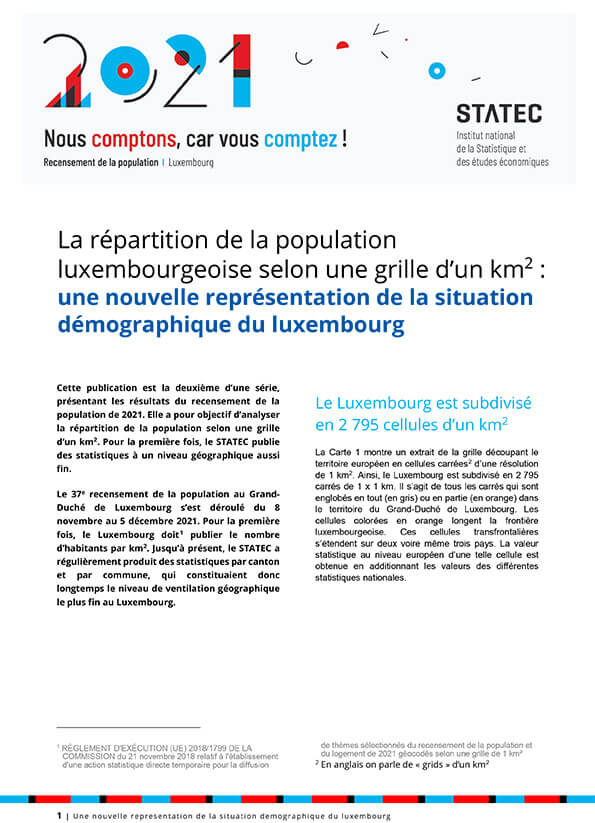Distribution per km²
-
Luxembourg is subdivided into 2,795 cells of 1x1 km. For the first time, STATEC publishes statistics at such a fine geographical level.
2795
The distribution of Luxembourg's population according
to a 1 km² grid: a new representation of the demographic situation in Luxembourg
The objective of this publication is to analyse the distribution of the population according to a 1-km² grid. Thus, Luxembourg is subdivided into 2,795 squares of 1 x 1 km. For the first time, STATEC publishes statistics at such a fine geographical level.
The city of Luxembourg and its surroundings, as well as the southwest of the country, are the most populated
The 643,941 inhabitants counted in the population census are not evenly distributed across the country. The one km² grid cells in the southern part of Luxembourg, which are more urbanised, are much more densely populated than those in the rural regions of the centre and north of the country. Note that 41.5% of the cells are not inhabited at all. These are mainly agricultural and forest areas, where the construction of residential buildings is generally prohibited. In addition, the cells along the national borders are largely uninhabited.
Of the occupied cells, 48.0% are inhabited by 1 to 499 persons (in white). The overwhelming majority of the territory (89.5%) is not at all or only sparsely populated. Only 7.9% of the squares are already more densely populated, with between 500 and 1,999 people concentrated in one km2 (in beige).
The cells with more than 1,999 inhabitants are relatively rare and cover the most urban areas of the country. 2.0% of the cells are populated by 2,000 to 4,399 inhabitants (in light orange), 0.5% by 4,400 to 8,999 inhabitants (in dark orange) and only 0.1% by more than 8,999 inhabitants (in dark red).
It is in the City of Luxembourg and its surroundings, as well as in the former mining basin in the south and south-west of Luxembourg, that the cells of one km2 have the highest populations. The most densely populated cell is located in the city of Luxembourg, with a population of 14,663 inhabitants over an area of 1 km2. The second most populated cell is in the commune of Esch-sur-Alzette, with 11,196 residents.
Focus on the canton of Luxembourg
With 197,932 inhabitants, the canton of Luxembourg is the most populated canton in the 2021 population census. It alone accounts for 30.7% of Luxembourg's residents.
Map 5 shows the extent to which the population of the canton of Luxembourg is concentrated in Luxembourg City. The capital gathers 64.7% of the population of the canton (128,097 inhabitants).
The territory of the canton of Luxembourg is subdivided into 294 cells of one km2 in size, which make up all or part of the territory in question. The grid cells of the City of Luxembourg are the most densely populated, while those covering the neighbouring communes are much less so. The urban extensions to the south, west and north mentioned above are clearly visible.
The grid cell of the City of Luxembourg that stretches between the districts of Gare, Bonnevoie-Nord and Bonnevoie-Sud is the most densely populated (14,663 inhabitants). The other adjacent squares are also densely populated. The further away from the urban centre, the more frequent are the low-population cells. 34.0% of them are not inhabited at all. The grey cells to the north-east of the capital, which cover the forest area of the Gréngewald, are a good example.
Focus on the canton of Esch-sur-Alzette
The canton of Esch-sur-Alzette is the second most populated canton in Luxembourg. On 8 November 2021, 186,224 residents, or 28.9% of the national population, were counted in the canton located in the south-west of the country.
The population is distributed polycentrically across the canton of Esch-sur-Alzette. The grids with the highest populations are those covering the urban centres of Esch-sur-Alzette, Dudelange, Schifflange, Differdange and Pétange. The most populated cell is located in Esch-sur-Alzette, with 11,196 people in a 1 km2 area. This square kilometre covers mainly the Uecht district, as well as a small part of the Brill, Bruch and Al Esch districts. The other most densely populated squares have between 4,400 and 8,999 inhabitants. The less densely populated towns, such as Bettembourg, Rumelange, Kayl, Rodange, etc., also stand out on the map, with cells with between 2,000 and 4,999 inhabitants.
Many cells are also very sparsely populated, or even deserted, especially in the northern and eastern parts of the canton. Thus, one third of the cells in the canton are not inhabited at all, while 40.8% are inhabited by 1 to 499 people (in white).
Population census maps
on the national geoportal
STATEC, in collaboration with the Administration du cadastre et de la topographie, makes interactive maps with the results of the population census available on the Luxembourg geoportal at the following address:
More results
In the coming months, various publications will be produced for the public, but also for the public specialised in demographic issues. At the same time, statistical tables on the various census topics will be published on the Statistics Portal.
Find out more about the distribution
of the Luxembourgish population according to a 1-km² grid
News
Why is the census important?
Census results are essential information for public policy decision-making.
Census data help to forecast needs for land use planning, schools, nurseries, hospitals, retirement and nursing homes, housing, etc.
Last update


